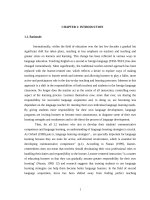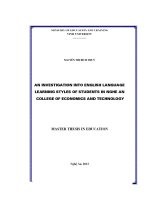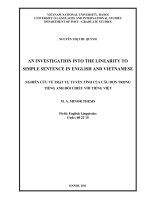An investigation into english vietnamese translation of euphemisms in public speeches
Bạn đang xem bản rút gọn của tài liệu. Xem và tải ngay bản đầy đủ của tài liệu tại đây (2.93 MB, 124 trang )
VIETNAM NATIONAL UNIVERSITY, HANOI
UNIVERSITY OF LANGUAGES AND INTERNATIONAL STUDIES
FACULTY OF POST – GRADUATE STUDIES
TRẦN THỊ THANH
AN INVESTIGATION INTO ENGLISH – VIETNAMESE
TRANSLATION OF EUPHEMISMS IN PUBLIC SPEECHES
(Phân tích cách dịch uyển ngữ trong các bài diễn văn tiếng Anh sang tiếng Việt )
M.A MINOR THESIS
Hanoi, 2020
VIETNAM NATIONAL UNIVERSITY, HANOI
UNIVERSITY OF LANGUAGES AND INTERNATIONAL STUDIES
FACULTY OF POST – GRADUATE STUDIES
TRẦN THỊ THANH
AN INVESTIGATION INTO ENGLISH – VIETNAMESE
TRANSLATION OF EUPHEMISMS IN PUBLIC SPEECHES
(Phân tích cách dịch uyển ngữ trong các bài diễn văn tiếng Anh sang tiếng Việt )
M.A MINOR THESIS
Field: English Linguistics
CodeODE: 8220201.01
Supervisor: Phạm Thị Thủy, Ph.D
Hanoi, 2020
DECLARATION
I certify that all the material in this study which is not my own work has been
identified and acknowledged, and that this thesis is the result of my own
research and the substance of the thesis has not, wholly or in part, has
submitted for any degree to any other universities and institutions.
i
ACKNOWLEDGEMENTS
My thesisstudy has been only completed successfully with the assistant and
guidance of my teachers, my friends, and my relatives.
First and foremost, I would like to express my sincere gratitude for my
supervisor, Doctor of PhilosophyAssoc. Prof. Phạm Thị Thủy for her
valuable suggestions, academic guidance, critical comments and practical
advices, without which, the thesisstudy could not come into being.
I am also grateful to all my teachers at University of Languages and
International Studies for their useful lectures, much help and encouragement.
In addition, my thanks also to my friends for their ideas, material and
enthusiasm during my whole course of studying.
Last but not least, I wish to acknowledge the support and invaluable help of
my parents while the work was in progress.
ii
ABSTRACT
Translation from one language to another, particularly translation of
euphemisms, is no easy task. Euphemisms are a figurative device which are
used in life and at work by almost everyone, from ordinary people to
politicians, including presidents, in order to avoid directness of speech and
embarrassing or unpleasant expressions.
The present thesis focuses on the methods of English- Vietnamese translation
of euphemisms, more specifically, in public speeches. The aim of this thesis is
to find out the main methods that the translators use to translate euphemisms
for death in English public speeches into Vietnamese.
To achieve that aim, we have taken the data from 63 English public speeches
and their translations in Vietnamese. Altogether, 37 euphemisms for death
(see appendix 4) have been collected. The data then has been analyzed to
discover the methods that the translators have employed.
The analytical framework for translating euphemisms for death from English
into Vietnamese is taken from translation methods provided by Larson (1998)
and Barnwell (1980).
The finding shows that 82% the euphemisms for death in the English public
speeches have been translated by equivalent euphemisms in Vietnamese, 12%
euphemisms
have
been
translated
indirectly or
by non-equivalent
euphemisms, and 6% euphemisms – by direct forms in Vietnamese texts.
iii
Euphemism is a figurative device which is almost used by everyone in
many aspects of life, especially by president in public speeches so that they
can avoid the directness of speech or the ugly expressions. This thesis is a
case study which investigates methods translators have used when they
translate euphemism for death from English into Vietnamese in linguistic and
culture difference between two languages. The study examines some
sentences which contain death euphemism in public speeches and analyzed.
For its framework for analysis, the present case study will assess the
translation of English euphemisms into Vietnamese in public speeches by
focusing on three ways of translating euphemisms.
The study concludes that the most of the euphemisms in the SL texts are
transferred by equivalent euphemism in the TL texts, some in the SL texts are
transferred indirectly or by non-equivalent euphemisms in the TL texts, a
small number are transferred by a direct form in the TL texts.
The principal aim of this study is to explore how many euphemisms for death
are used in public speeches. Moreover, it also aims to come to main methods
taken by translators in translating euphemisms for death from English public
speeches into Vietnamese.
In doing so, this thesis attempts to study the figure of speech on the aspect of
translation to give some considerations and propose methods in translating
euphemisms for death in public speeches.
iv
TABLE OF CONTENTS
DECLARATION ......................................................................................................... i
ACKNOWLEDGEMENTS ........................................................................................ii
ABSTRACT .............................................................................................................. iii
TABLE OF CONTENTS ......................................................................................... viv
ABBREVIATION ................................................................................................ xiivii
LIST OF TABLES ............................................................................................. xiiiviii
LIST OF FIGURES...............................................................................................xviix
CHAPTER I: INTRODUTION................................................................................... 1
1.1. Rationale of the thesis ....................................................................................... 1
1.2. Aims and objectives of the thesis ..................................................................... 1
1.2.1. Aims ........................................................................................................... 1
1.2.2. Objectives ................................................................................................... 2
1.3. Research method of the thesis .......................................................................... 2
1.3.1. Research method ........................................................................................ 2
1.3.2. Research questions ..................................................................................... 2
1.4. Scope of the thesis ............................................................................................ 2
1.5. Significance of the thesis .................................................................................. 2
1.6. Organization of the thesis ................................................................................. 3
CHAPTER II. LITERATURE REVIEW.................................................................. 54
2.1. Translation .............................................................................................. 4
2.1.1. Definitions of translation .......................................................................... 54
2.1.2. Translation equivalence ............................................................................ 75
2.1.3. Translation process and translation methods in general .......................... 98
2.1.4. Methods for translating euphemisms ................................................... 1312
v
2.2. Language and culture .................................................................................. 1413
2.3. Euphemisms ................................................................................................ 1615
2.3.1. Definition of public speech .................................................................. 1615
2.3.2. Definitions of euphemism .................................................................... 1715
2.3.3. Classification of euphemism ................................................................ 1816
2.3.4. Euphemisms for death .......................................................................... 2019
2.4. Chapter summary ........................................................................................ 2620
CHAPTER III: RESEARCH METHOD .............................................................. 2821
3.1. Research method ......................................................................................... 2821
3.1.1. Research method .................................................................................. 2821
3.1.2. Research questions ............................................................................... 2821
3.2. Research design .......................................................................................... 2821
3.3. Data collection and analysis ....................................................................... 2922
3.3.1. Data collection ...................................................................................... 2922
3.3.2. Data analysis ......................................................................................... 3023
3.4. Chapter summary ........................................................................................ 3124
CHAPTER IV: FINDINGS AND DISCUSSIONS .............................................. 3225
4.1. Euphemisms in the SL translated by direct form in the TL texts ............... 3325
4.2. Euphemisms in the SL translated by equivalent euphemisms in the TL texts .... 3729
4.3. Euphemisms in the SL translated indirectly or by non-equivalent euphemisms
in the TL texts. ................................................................................................... 4234
4.4. Frequency of methods for translating death euphemisms .......................... 4637
4.5. Chapter summary ........................................................................................ 4739
CHAPTER V: CONCLUSION ............................................................................. 5040
5.1. Conclusion .................................................................................................. 5040
vi
5.2. Implications for translation studies and language teaching ........................ 5242
5.3. Some limitations of the thesis ..................................................................... 5242
5.4. Some suggestions for further research ........................................................ 5343
REFERENCES ...................................................................................................... 5444
APPENDIXES ............................................................................................................ I
APPENDIX 1: A dictionary Euphemisms & Other doubletalk .............................. I
APPENDIX 2: How Not To Say What You Mean: A Dictionary of Euphemisms ..IVIII
APPENDIX 3: Data collected ............................................................................XIX
APPENDIX 4: Euphemisms for death ............................................... XLVXXXVII
APPENDIX 5: Non- euphemisms for death ...................................... XLVIIXXXIX
DECLARATION ......................................................................................................... i
ACKNOWLEDGEMENTS ........................................................................................ii
ABSTRACT .............................................................................................................. iii
TABLE OF CONTENTS ........................................................................................... iv
ABBREVIATION ...................................................................................................... vi
LIST OF TABLES ....................................................................................................vii
LIST OF FIGURES................................................................................................. viii
CHAPTER I: INTRODUTION................................................................................... 1
1.1. Rationale of the thesis ....................................................................................... 1
1.2. Aims and objectives of the thesis ..................................................................... 1
1.2.1. Aims ........................................................................................................... 1
1.2.2. Objectives ................................................................................................... 2
1.3. Research method of the thesis .......................................................................... 2
1.4. Scope of the thesis ............................................................................................ 2
1.5. Significance of the thesis .................................................................................. 2
1.6. Organization of the thesis ................................................................................. 2
CHAPTER II. LITERATURE REVIEW.................................................................... 4
2.1. Definitions of translation .................................................................................. 4
2.2. Translation equivalence .................................................................................... 5
vii
2.3. Language and culture ........................................................................................ 8
2.4. Euphemisms ...................................................................................................... 9
2.4.1. Definition of public speech ........................................................................ 9
2.4.2. Definitions of euphemism ........................................................................ 10
2.4.3. Classification of euphemism .................................................................... 11
2.5. Translation methods........................................................................................ 14
2.5.1. Translation process and translation method in general ............................ 14
2.5.2. Methods for translating euphemisms ....................................................... 17
2.6. Chapter summary ............................................................................................ 19
CHAPTER III: RESEARCH METHOD .................................................................. 20
3.1. Research method ............................................................................................. 20
3.1.1. Research method ...................................................................................... 20
3.1.2. Research questions ................................................................................... 20
3.2. Research design .............................................................................................. 20
3.3. Data collection and analysis ........................................................................... 21
3.3.1. Data collection .......................................................................................... 21
3.3.2. Data analysis ............................................................................................. 22
3.4. Chapter summary ............................................................................................ 23
CHAPTER IV: FINDINGS AND DISCUSSION .................................................... 24
4.1. Euphemisms for death .................................................................................... 24
4.2. Findings and discussion .................................................................................. 24
4.2.1. Euphemisms in the SL translated by direct form in the TL texts............. 25
4.2.2. Euphemisms in the SL translated by equivalent euphemisms in the TL
texts..................................................................................................................... 29
4.2.3. Euphemisms in the SL translated indirectly or by non-equivalent
euphemisms in the TL texts................................................................................ 34
4.2.4. Frequency of methods for translating death euphemisms ........................ 37
4.3. Chapter summary ............................................................................................ 39
CHAPTER V: CONCLUSION ................................................................................. 40
5.1. Conclusion.......................................................................................................... 40
5.2. Implications for translation studies and language teaching ............................... 42
viii
5.3. Some limitations of the thesis ............................................................................ 42
5.4. Some suggestions for further research ............................................................... 43
REFERENCES .......................................................................................................... 44
APPENDIXES ............................................................................................................ I
APPENDIX 1: A dictionary Euphemisms & Other doubletalk .............................. I
APPENDIX 2: How Not To Say What You Mean: A Dictionary of EuphemismsIII
APPENDIX 3: Data collected ...............................................................................IX
APPENDIX 4: Euphemisms for death ........................................................XXXVII
APPENDIX 5: Non- euphemisms for death ................................................. XXXIX
..........................................................................................................................
DECLARATION ............................................................................................ i
ACKNOWLEDGEMENTS ........................................................................... ii
ABSTRACT .................................................................................................. iii
TABLE OF CONTENTS .............................................................................. iv
ABBREVIATION ......................................................................................... vi
LIST OF TABLES ....................................................................................... vii
LIST OF FIGURES .................................................................................... viii
CHAPTER IPART A: INTRODUCTION .................................................... 1
1.1. Rationale of the thesis ............................................................................. 1
1.2. Aims and Objectives of the thesis........................................................... 1
1.3. Research methods of the thesis ............................................................... 2
1.4. Scope of the thesis .................................................................................. 2
1.5. Signification of the thesis........................................................................ 2
1.6. Organization of the thesis ....................................................................... 2
PART B: DEVELOPMENT .......................................................................... 4
CHAPTER II. LITERATURE REVIEW ...................................................... 4
ix
21.1. Definitions of translation ...................................................................... 4
21.2. Translation equivalence ........................................................................ 5
21. 3. Language and culture ........................................................................... 8
21.4. Euphemisms .......................................................................................... 9
21.4.1. Definition of public speech ............................................................... es
21.4.2. Definitions of euphemisms .............................................................. 10
21.4.3. Classification of euphemism ............................................................ 11
21.5. Translation methods ............................................................................ 13
21.5.1. Translation process and translation method in general.................... 14
21.5.2. Methods for translating euphemisms ............................................... 17
21.6. Chapter summary Conclusion ............................................................. 18
CHAPTER III: RESEARCH METHODS ................................................... 20
32.1. Research methods ............................................................................... 20
32.1.1. Research methods ............................................................................ 20
32.1.2. Research questions ........................................................................... 20
32.2. Research design................................................................................... 20
32.3. Data collection and analysis................................................................ 21
32.3.1. Data collection ................................................................................. 21
32.3.2. Data analysis .................................................................................... 22
32.4. Chapter summary Conclusion ............................................................. 23
CHAPTER IVII: FINDINGS AND DISCUSSION .................................... 24
43.1. Euphemisms for death......................................................................... 24
43.2. Findings and discussions..................................................................... 24
4.2.1.Euphemisms in the SL translated by direct form in the TL texts ....... 29
x
9
43.2.2.Euphemisms in the SL translated by equivalent euphemisms in the
TL texts ........................................................................................................ 29
34.2.3. Euphemisms in the SL translated indirectly or by non-equivalent
euphemisms in the TL texts. ........................................................................ 34
34.2.4. Frequency of methods for translating death euphemisms ............... 37
34.3. Chapter summary Conclusion ............................................................. 39
CHAPTER V: CONCLUSION.................................................................... 40
5.1. Conclusion ............................................................................................ 40
5.2. Implications for translation studies and language teaching .................. 42
5.3. Some limitations of the thesis ............................................................... 42
5.4. Some suggestions for further research .................................................. 43
REFERENCES............................................................................................. 44
APPENDIXCES.............................................................................................. I
APPENDIX 1 A dictionary Euphemisms & Other doubletalk ....................... I
APPENDIX 2 How Not To Say What You Mean: A Dictionary of
Euphemisms ................................................................................................. III
APPENDIX 3 Data collected ..................................................................... IX
APPENDIX 4 Euphemisms for death ................................................ XXXVII
APPENDIX 5 Non- euphemisms about death .................................... XXXIX
...........................................................................................................................................................
xi
ABBREVIATION
No.
Words
Meaning
1
SL Texts
Source language Texts
2
TL Texts
Target language Texts
xii
LIST OF TABLES
Table 1. Death euphemisms in English translated by direct forms in
Vietnamese. ................................................................................... 3729
Table 2. Death euphemisms in English translated by equivalent euphemism
in Vietnamese ................................................................................ 4233
Table 3. Euphemisms in English translated by non - equivalent euphemisms
in Vietnamese ................................................................................ 4537
Table 4. Frequency of translation methods euphemisms for death ............ 4638
Table 5. Non- euphemisms about death ...................................... XLVIIXXXIX
Table 1.Death euphemisms in English translated by direct forms in
Vietnamese. ......................................................................................... 37292929
Table 2. Death euphemisms in English translated by equivalent euphemism
in Vietnamese ...................................................................................... 42333333
Table 3. Euphemisms in English translated by non - equivalent euphemisms
in Vietnamese ...................................................................................... 45373737
Table 4. Frequency of translation methods euphemisms for death .... 46383838
Table 5. Non- euphemisms about death ................................................ XXXVII
xiii
LIST OF FIGURES
Figure 1. Example of euphemisms in the SL translated by direct form in the
TL texts .......................................................................................................... 26
Figure 2. Example of euphemisms in the SL translated by direct form in the
TL texts .......................................................................................................... 27
Figure 3. Example of euphemisms in the SL translated by direct form in the
TL texts .......................................................................................................... 28
Figure 4. Example of euphemisms in the SL translated by equivalent
euphemisms in the TL texts ........................................................................... 30
Figure 5. Example of euphemisms in the SL translated by equivalent
euphemisms in the TL texts ........................................................................... 31
Figure 6. Example of euphemisms in the SL translated by equivalent
euphemisms in the TL texts ........................................................................... 31
Figure 7. Example of euphemisms in the SL translated by equivalent
euphemisms in the TL texts ........................................................................... 32
Figure 8. Example of euphemisms in the SL translated indirectly or by nonequivalent euphemisms in the TL texts .......................................................... 34
Figure 9. Example of euphemisms in the SL translated indirectly or by nonequivalent euphemisms in the TL texts .......................................................... 35
xiv
Figure 10. Example of euphemisms in the SL translated indirectly or by nonequivalent euphemisms in the TL texts .......................................................... 36
Figure 11: Proportion of Vietnamese euphemisms translated from English by
three translation methods .................................................................... 46383838
xv
LIST OF FIGURES
Diagram 1. Translation process by Barnwell .................................................... 8
Diagram 2. Translation process by Larson ....................................................... 9
Diagram 3. Translation process by Nida and Taber ....................................... 10
Diagram 4. Translation methods by Newmark ............................................... 11
Figure 1. Example of euphemisms in the SL translated by direct form in the
TL texts.......................................................................................... 3426
Figure 2. Example of euphemisms in the SL translated by direct form in the
TL texts.......................................................................................... 3527
Figure 3. Example of euphemisms in the SL translated by direct form in the
TL texts.......................................................................................... 3628
Figure 4. Example of euphemisms in the SL translated by equivalent
euphemisms in the TL texts. ......................................................... 3830
Figure 5. Example of euphemisms in the SL translated by equivalent
euphemisms in the TL texts .......................................................... 3931
Figure 6. Example of euphemisms in the SL translated by equivalent
euphemisms in the TL texts .......................................................... 3931
Figure 7. Example of euphemisms in the SL translated by equivalent
euphemisms in the TL texts .......................................................... 4032
Figure 8. Example of euphemisms in the SL translated indirectly or by nonequivalent euphemisms in the TL texts. ........................................ 4334
Figure 9. Example of euphemisms in the SL translated indirectly or by nonequivalent euphemisms in the TL texts ......................................... 4435
Figure 10. Example of euphemisms in the SL translated indirectly or by nonequivalent euphemisms in the TL texts ......................................... 4436
xvi
Figure 11: Proportion of Vietnamese euphemisms translated from English by
three translation methods. ............................................................. 4738
xvii
CHAPTER IPART A: INTRODUTION
1.1. Rationale of the thesisstudy
Communication is the backbone of our society. It is an effective tool for us to
form connections, influence decisions, and motivate change. Public speeches
are one of the most important and most dreaded forms of communication.
From language perspective, euphemism is a key to communicate in public
speeches effectively and appropriately, and also use to protect speakers from
undesired emotional arousal, so euphemism translation is not easy task. It is
not only translated including the texts, the rules of grammar of two languages
but also from one culture to another. Therefore, the translation of euphemisms
has become more and more important in intercultural communication for
translators, in general, and English learners in particular.
Among the Master Theses at University of Languages and International
Studies, VNU, there has been a study “Euphemism in English and
Vietnamese - A contrastive analysis from Cultural perspective” (Nguy n Th
Qu nh Chi, 2005). However, translation ofng euphemisms for death from
English into Vietnamese, has not yet been extensively studied, especially in
public speeches.
Therefore, this thesis attempts to study the figure of speech on the aspect of
translation to give some considerations and propose methods in translating
euphemisms for death in public speeches.
1.2. Aims and objectives of the thesisstudy
1.2.1. Aims
The principal aim of this thesis study is to explore how many euphemisms for
death are used in public speeches. Moreover, it also aims to come to main
methods taken by translators in translating euphemisms for death from
English public speeches into Vietnamese.
1
1.2.2. Objectives
To achieve the above-stated aims, the following objectives are identified:
- To examine how many methods of translating are used by translators in
public speeches from English into Vietnamese.
- And to suggest some considerations and recommendations for euphemism
translation and for language teaching.
1.3. Research methods of the thesis
1.3.1. Research methodthe study
The present case studystudy will assess the translation of English euphemisms
into Vietnamese in public speeches by focusing on three ways of translating
euphemisms
1.3.2. Research questions
To achieve the aims and objectives mentioned above, this thesis tries to
answer the following questions.
1. How euphemisms are translated from English into Vietnamese as seen in
examples taken from public speeches?
2. What is the main method taken by translators when translating euphemisms
from English into Vietnamese?
1.4. Scope of the thesisthe study
This thesisstudy investigates the ways used in translating euphemisms for
death from English into Vietnamese. The investigation will focus on works of
English public speeches and their Vietnamese versions.
1.5. Significancetion of the thesisstudy
We hope this thesisstudy will make useful contribution for translators in terms
of euphemism for death translation from English into Vietnamese. In addition,
Vietnamese speakers can learn the ways euphemisms are used in public
speeches.
2
1.6. Organization of the thesisthe study
This thesisstudy consists of five chaptersthree main parts, references, and 54
appendixcxes.
Chapter IPart A: Introduction
Chapter 1 The introduction presents the rationale, signification of the
thesisstudy, research methods of the thesisstudy, scope of the thesisstudy and
the organization of the thesisstudy.
Chapter II: Literature review
Part B: Development
The development comprises three chapters.
Chapter 2 Chapter 1 is the review of the previous studies and the theoretical
background for the thesisstudy. Some theoretical preliminaries on translation,
the definitions, and classifications of euphemism are introduced in this
chapter.
Chapter III: Research methods
Chapter 32 is methodology and procedure of the thesisstudy. Research
questions, data collection, and research method are presented in this chapter.
Chapter IV: Findings and discussion
Chapter 3 4 is findings and discussion of methodways used in translating
euphemisms from English into Vietnamese.
Chapter VPart C: Conclusion
This part gives the conclusion of the whole thesisstudy, the implications for
the translation studies and languagetranslation teaching, limitations of the
thesis study and suggestions for further research.
References include all the books, articles that have been referred in the thesis.
Fiveour appendixxes list euphemisms about death in order of euphemisms
dictionary books, data collected, euphemisms for death and non- euphemisms
for death.
3
4
PART B: DEVELOPMENT
CHAPTER II. LITERATURE REVIEW
This chapter deals with the concepts related to translating euphemisms.
It discusses definitions of translation and translation equivalence from
linguistic perspectives, different definitions and classification of euphemisms,
euphemisms for death, and the relationship between language and culture.
Moreover, methods for translating euphemisms will be presented.
2.1. Translation
12.1.1. Definitions of translation
In modern world, translation plays a crucial role not only in linguistics
but also in other fields, such as business, foreign affairs, etc because
professional translation provides companies with a competitive edge over
their market rivals when they are able to communicate effectively with
foreign clients in the language of the customers. Also, translation has become
an important profession because it consists of staff translators, freelancers,
contract translators, terminologists, and pre- and post- editors in machine
translation.
Translation is the process of changing something that is written or
spoken into another language (Oxford Advanced Learners‟ dictionary,
Turnbull et al, 2010, p.1646)
Translation is the transfer process of a text from a language (source
language) into another language (target language). Specifically, it is a
connecting bridge between source language and target language. More
importantspecifically, source language (SL) is the language in which the
original author of a message formulated it, and the point of departure for
translation (Nida, 1982, p. 206) or it is expressed message in specific
5









